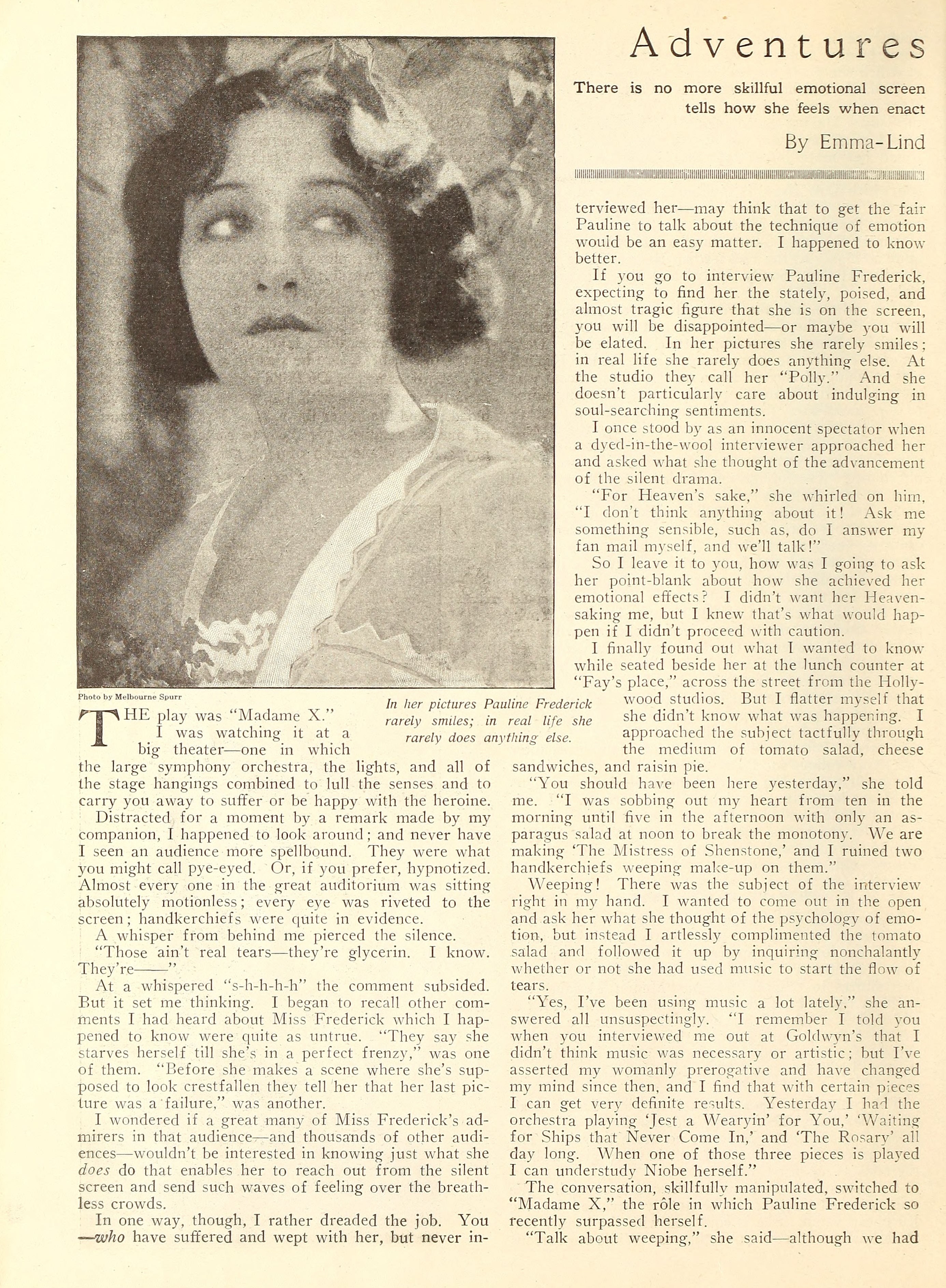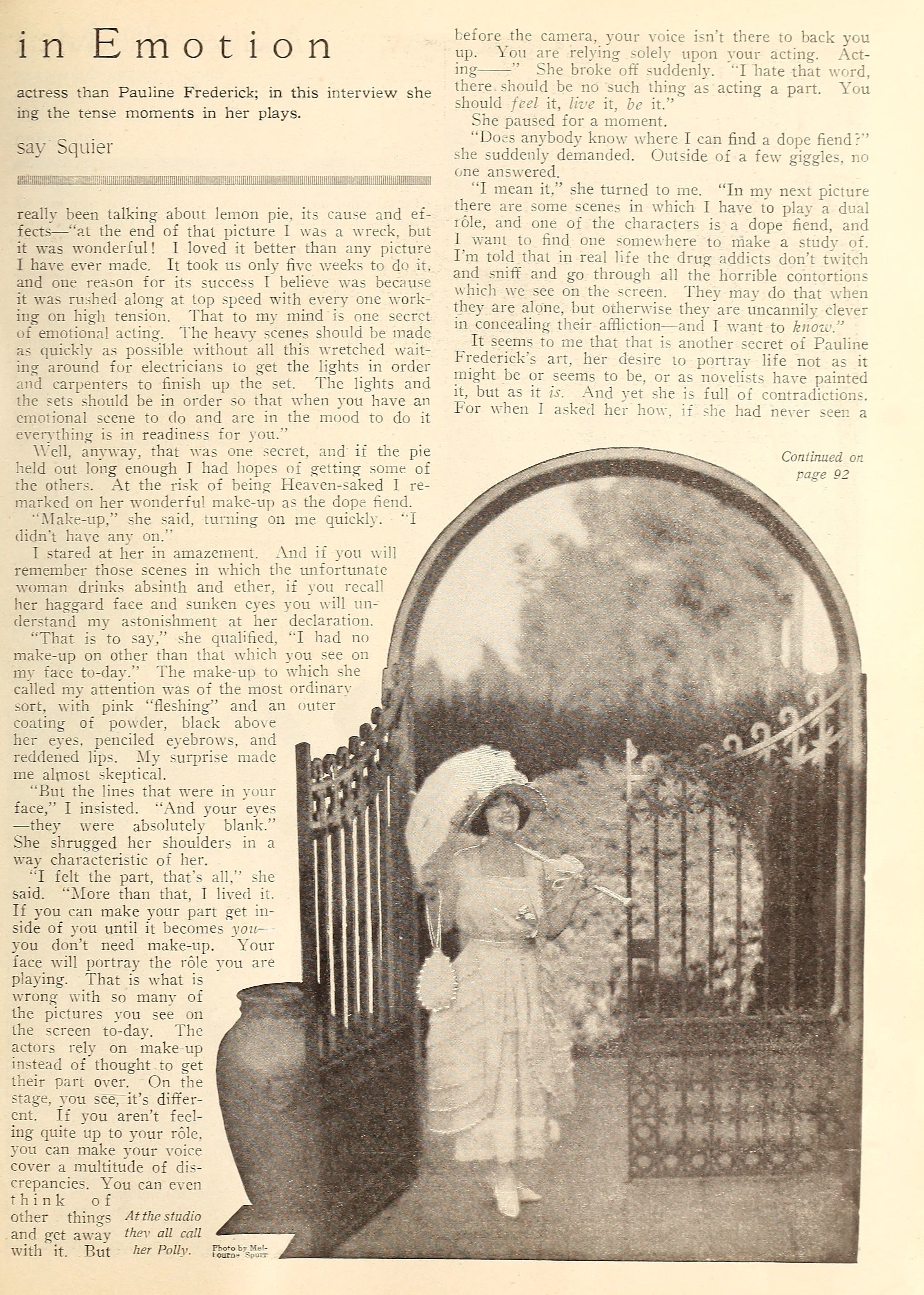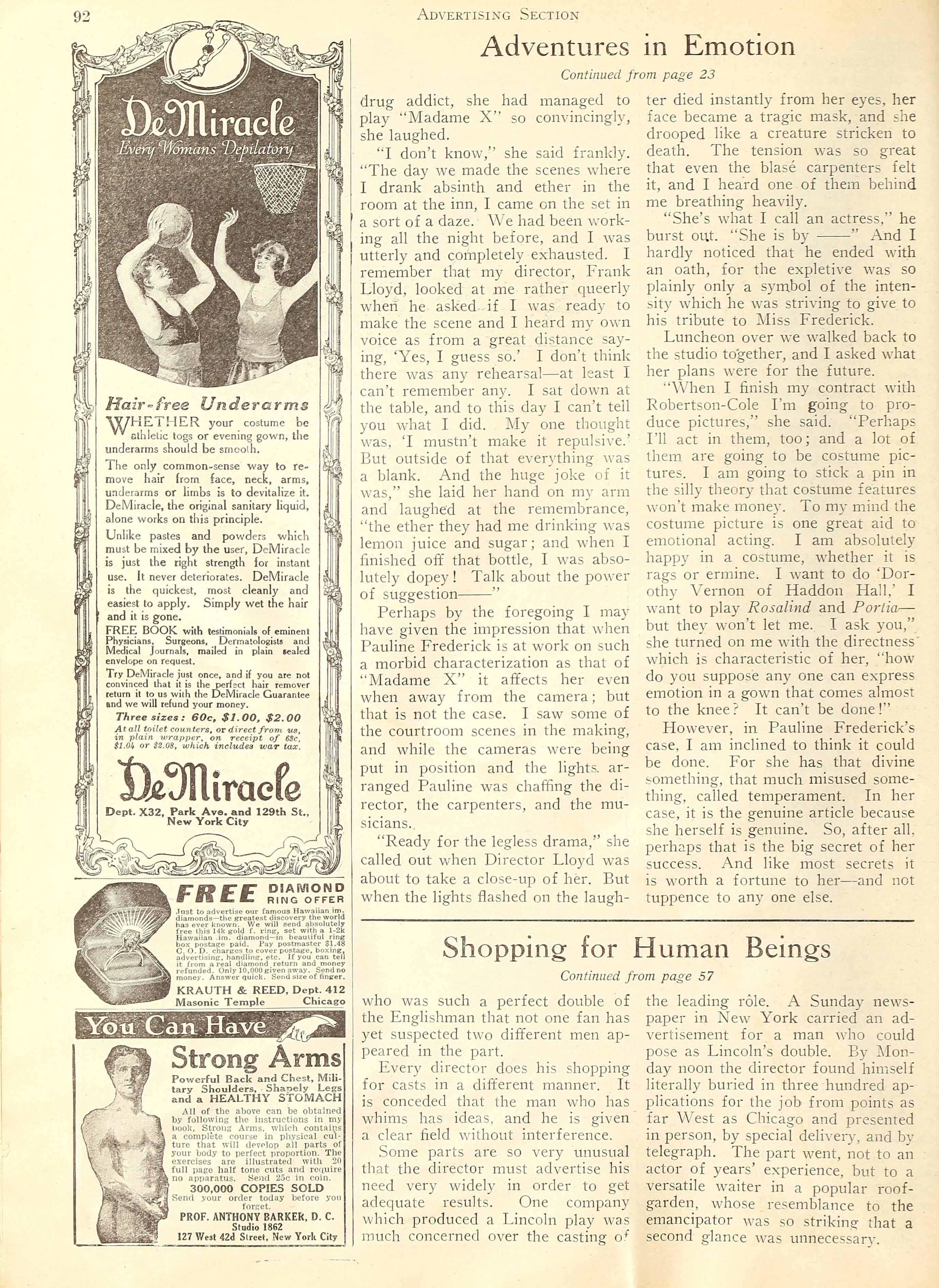Pauline Frederick — Adventures in Emotion (1921) 🇺🇸

The play was “Madame X.” I was watching it at a big theater — one in which the large symphony orchestra, the lights, and all of the stage hangings combined to lull the senses and to carry you away to suffer or be happy with the heroine.
by Emma-Lindsay Squier
Distracted for a moment by a remark made by my companion, I happened to look around; and never have I seen an audience more spellbound. They were what you might call pye-eyed. Or, if you prefer, hypnotized. Almost every one in the great auditorium was sitting absolutely motionless; every eye was riveted to the screen; handkerchiefs were quite in evidence.
A whisper from behind me pierced the silence.
“Those ain’t real tears — they’re glycerin. I know. They’re —”
At a whispered “s-h-h-h-h” the comment subsided. But it set me thinking. I began to recall other comments I had heard about Miss Frederick which I happened to know were quite as untrue. “They say she starves herself till she’s in a perfect frenzy,” was one of them. “Before she makes a scene where she’s supposed to look crestfallen they tell her that her last picture was a failure,” was another.
I wondered if a great many of Miss Frederick’s admirers in that audience — and thousands of other audiences — wouldn’t be interested in knowing just what she does do that enables her to reach out from the silent screen and send such waves of feeling over the breathless crowds.
In one way, though, I rather dreaded the job. You — who have suffered and wept with her, but never interviewed her — may think that to get the fair Pauline to talk about the technique of emotion would be an easy matter. I happened to know better.
If you go to interview Pauline Frederick, expecting to find her the stately, poised, and almost tragic figure that she is on the screen, you will be disappointed — or maybe you will be elated. In her pictures she rarely smiles: in real life she rarely does anything else. At the studio they call her “Polly.” And she doesn’t particularly care about indulging in soul-searching sentiments.
I once stood by as an innocent spectator when a dyed-in-the-wool interviewer approached her and asked what she thought of the advancement of the silent drama.
“For Heaven’s sake,” she whirled on him, “I don’t think anything about it! Ask me something sensible, such as, do I answer my fan mail myself, and we’ll talk!”
So I leave it to you, how was I going to ask her point-blank about how she achieved her emotional effects? I didn’t want her Heaven-saking me, but I knew that’s what would happen if I didn’t proceed with caution.
I finally found out what I wanted to know while seated beside her at the lunch counter at “Fay’s place,” across the street from the Hollywood studios. But I flatter myself that she didn’t know what was happening. I approached the subject tactfully through the medium of tomato salad, cheese sandwiches, and raisin pie.
“You should have been here yesterday,” she told me. “I was sobbing out my heart from ten in the morning until five in the afternoon with only an asparagus salad at noon to break the monotony. We are making The Mistress of Shenstone, and I ruined two handkerchiefs weeping make-up on them.”
Weeping! There was the subject of the interview right in my hand. I wanted to come out in the open and ask her what she thought of the psychology of emotion, but instead I artlessly complimented the tomato salad and followed it up by inquiring nonchalantly whether or not she had used music to start the flow of tears.
“Yes, I’ve been using music a lot lately,” she answered all unsuspectingly. “I remember I told you when you interviewed me out at Goldwyn’s that I didn’t think music was necessary or artistic; but I’ve asserted my womanly prerogative and have changed my mind since then, and I find that with certain pieces I can get very definite results. Yesterday I had the orchestra playing Jest a Wearyin’ for You, Waiting for Ships that Never Come In, and The Rosary all day long. When one of those three pieces is played I can understudy Niobe herself.”
The conversation, skillfully manipulated, switched to Madame X, the role in which Pauline Frederick so recently surpassed herself.
“Talk about weeping,” she said — although we had really been talking about lemon pie, its cause and effects— “at the end of that picture I was a wreck, but it was wonderful! I loved it better than any picture I have ever made. It took us only five weeks to do it. and one reason for its success I believe was because it was rushed along at top speed with every one working on high tension. That to my mind is one secret of emotional acting. The heavy scenes should be made as quickly as possible without all this wretched waiting around for electricians to get the lights in order and carpenters to finish up the set. The lights and the sets should be in order so that when you have an emotional scene to do and are in the mood to do it everything is in readiness for you.”
Well, anyway, that was one secret, and if the pie held out long enough I had hopes of getting some of the others. At the risk of being Heaven-saked I remarked on her wonderful make-up as the dope fiend.
‘‘Make-up,” she said, turning on me quickly. “I didn’t have any on.”
I stared at her in amazement. And if you will remember those scenes in which the unfortunate woman drinks absinth and ether, if you recall her haggard face and sunken eyes you will understand my astonishment at her declaration.
“That is to say,” she qualified, “I had no make-up on other than that which you see on my face to-day.” The make-up to which she called my attention was of the most ordinary sort, with pink “fleshing” and an outer coating of powder, black above her eyes, penciled eyebrows, and reddened lips. My surprise made me almost skeptical.
“But the lines that were in your face,” I insisted. “And your eyes — they were absolutely blank.” She shrugged her shoulders in a way characteristic of her.
“I felt the part, that’s all,” she said. “More than that, I lived it. If you can make your part get inside of you until it becomes you — you don’t need make-up. Your face will portray the role you are playing. That is what is wrong with so many of the pictures you see on the screen to-day. The actors rely on make-up instead of thought to get their part over. On the stage, you see, it’s different. If you aren’t feeling quite up to your role, you can make your voice cover a multitude of discrepancies. You can even think of other things and get away with it. But before the camera, your voice isn’t there to back you up. You are relying solely upon your acting. Acting —” She broke off suddenly. “I hate that word, there, should be no such thing as acting a part. You should feel it, live it, be it.” She paused for a moment.
“Does anybody know where I can find a dope fiend?” she suddenly demanded. Outside of a few giggles, no one answered.
“I mean it,” she turned to me. “In my next picture there are some scenes in which I have to play a dual role, and one of the characters is a dope fiend, and I want to find one somewhere to make a study of. I’m told that in real life the drug addicts don’t twitch and sniff and go through all the horrible contortions which we see on the screen. They may do that when they are alone, but otherwise they “are uncannily clever in concealing their affliction — and I want to know.”
It seems to me that that is another secret of Pauline Frederick’s art, her desire to portray life not as it might be or seems to be, or as novelists have painted it, but as it is. And yet she is full of contradictions. For when I asked her how, if she had never seen a drug addict, she had managed to play Madame X so convincingly, she laughed.
“I don’t know,” she said frankly. “The day we made the scenes where I drank absinth and ether in the room at the inn, I came on the set in a sort of a daze. We had been working all the night before, and I was utterly and completely exhausted. I remember that my director, Frank Lloyd, looked at me rather queerly when he asked if I was ready to make the scene and I heard my own voice as from a great distance saying, ‘Yes, I guess so.’ I don’t think there was any rehearsal — at least I can’t remember any. I sat down at the table, and to this day I can’t tell you what I did. My one thought was, ‘I mustn’t make it repulsive.’ But outside of that everything was a blank. And the huge joke of it was,” she laid her hand on my arm and laughed at the remembrance, “the ether they had me drinking was lemon juice and sugar; and when I finished off that bottle, I was absolutely dopey! Talk about the power of suggestion”
Perhaps by the foregoing I may have given the impression that when Pauline Frederick is at work on such a morbid characterization as that of Madame X it affects her even when away from the camera; but that is not the case. I saw some of the courtroom scenes in the making, and while the cameras were being put in position and the lights, arranged Pauline was chaffing the director, the carpenters, and the musicians.
“Ready for the legless drama,” she called out when Director Lloyd was about to take a close-up of her. But when the lights flashed on the laughter died instantly from her eyes, her face became a tragic mask, and she drooped like a creature stricken to death. The tension was so great that even the blasé carpenters felt it, and I heard one of them behind me breathing heavily.
“She’s what I call an actress,” he burst out. “She is by —” And I hardly noticed that he ended with an oath, for the expletive was so plainly only a symbol of the intensity which he was striving to give to his tribute to Miss Frederick.
Luncheon over we walked back to the studio together, and I asked what her plans were for the future.
“When I finish my contract with Robertson-Cole I’m going to produce pictures,” she said. “Perhaps I’ll act in them, too; and a lot of them are going to be costume pictures. I am going to stick a pin in the silly theory that costume features won’t make money. To my mind the costume picture is one great aid to emotional acting. I am absolutely happy in a costume, whether it is rags or ermine. I want to do Dorothy Vernon of Haddon Hall, I want to play Rosalind and Portia — but they won’t let me. I ask you,” she turned on me with the directness’ which is characteristic of her, “how do you suppose any one can express emotion in a gown that comes almost to the knee? It can’t be done!”
However, in Pauline Frederick’s case, I am inclined to think it could be done. For she has that divine something, that much misused something, called temperament. In her case, it is the genuine article because she herself is genuine. So, after all, perhaps that is the big secret of her success. And like most secrets it is worth a fortune to her — and not tuppence to any one else.

In her pictures Pauline Frederick rarely smiles; in real life she rarely does anything else.
Photo by: Melbourne Spurr (1888–1964)

At the studio they all call her Polly.
Photo by: Melbourne Spurr (1888–1964)

Collection: Picture Play Magazine, March 1921
